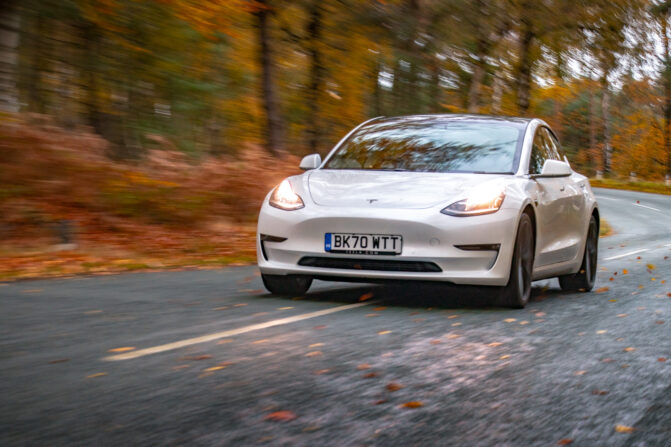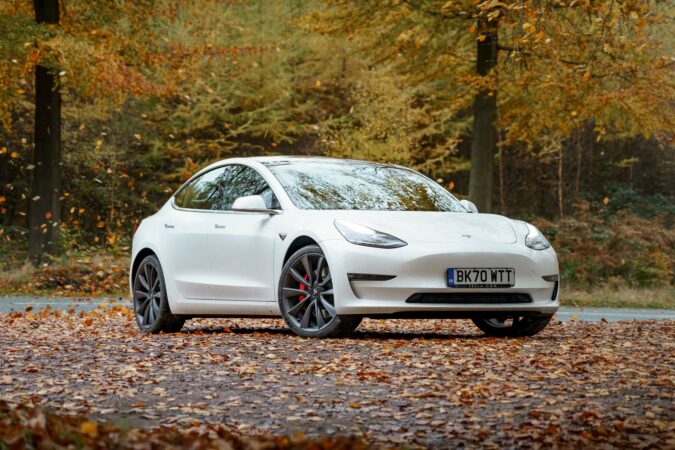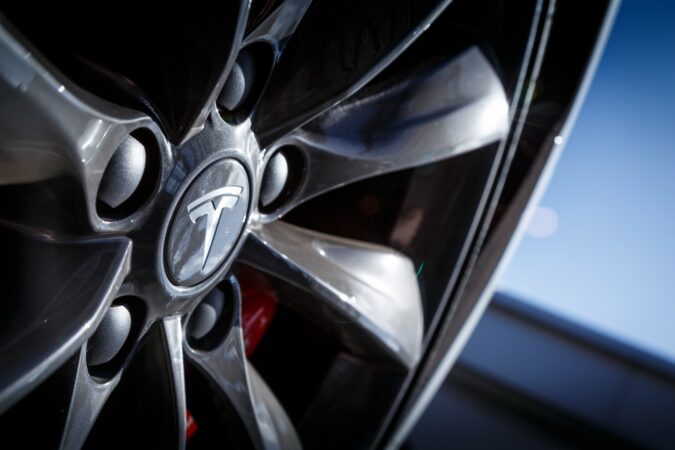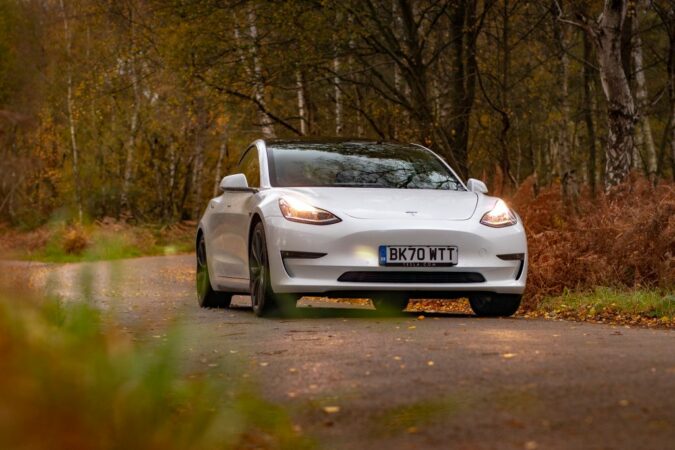The Tesla Model 3 is one of the most high-tech compact electric cars on the market. Of course, if you’re more about dizzying acceleration rather than advanced technology, Tesla will sell you a performance version. But what’s the Tesla Model 3 Performance horsepower figure?
For some reason, Tesla doesn’t disclose the Model 3’s horsepower figures on their website. Kind of weird since this is one of the most important figures in any car, no? In any case, here’s everything you need to know about the Tesla Model 3 Performance horsepower and more:
2022 Tesla Model 3 Performance
First, an overview of the Tesla Model 3 Performance and other trims in the lineup. The Model 3 is one of the best-selling electric cars right now, and Tesla currently offers three different versions of the 2022 Model 3:
- Rear-Wheel Drive. Single electric motor for the rear wheels, standard range battery that Tesla claims will do 272 miles. Acceleration from 0-60mph at 5.8 seconds, and a top speed of 140mph.
- Long Range AWD. Dual motor for the front and rear wheels, with Tesla’s “long-range battery” that they claim, will do 358 miles. Tesla claims acceleration from 0-60mph stands at 4.2 seconds and a top speed of 145mph.
- Performance. Dual motor and long-range battery just like the AWD model, but 0-60mph takes a much faster 3.1 seconds and a top speed of 162mph.
There are also smaller differences, mainly with the wheels and interior. The Performance gets the 20-inch Überturbine wheels, while the others can come with either 18-inch or 19-inch wheels. The standard rear-wheel drive version also comes with what Tesla calls a “partial premium interior”, whilst the other two have a fully premium interior.
Prices start at a very reasonable $46,990. But if you want the Performance model, you’re going to have to pay around $63,000. Of course, the main question is what’s the Tesla Model 3 Performance horsepower figure? How much power are you getting for that nearly $16,000 premium? Could you start with a lower trim level instead, and use the savings to build a head-turning Model 3 that reflects your personality and performance preferences?
2022 Tesla Model 3 Performance Horsepower
As mentioned, Tesla doesn’t disclose the Model 3’s horsepower figure. But it’s widely believed that the Model 3 Performance makes around 450 horsepower; around 180 horsepower from the front motor, and another 270 horsepower or so from the rear motor.
However, there’s a lot of conflicting information. Some sites state that it has 480 horsepower, nearly 30 horsepower more than the common belief. Also, we scoured through Reddit and see if anyone knows better. And some European owners of the Model 3 state that the registration says 513 horsepower.
Of course, when there’s conflicting information like this, the best way to find out is to put the car on the dyno and test it. And that’s exactly what Youtuber Misha Charoudin did:
Dyno Testing The Tesla Model 3 Performance
The dynamometer or dyno testing is a method of measuring a car’s horsepower output by putting it on rollers. These rollers spin along with the car’s wheels and then several electronic instruments calculate how much horsepower the car makes at the wheels.
If you already own a Tesla and you’re curious, you can dyno test it for around $150 per hour at tuning shops. But dyno testing a Tesla will require you to remove the under panels to strap the car onto the machine. And you’ll need to put it into Dyno Mode to disable all the safety features, otherwise, it won’t work.
If you don’t own a Tesla and are curious (while you’re here, do consider checking out our guide on how reliable are Teslas) about how much power the Model 3 Performance makes, watch this video:
Note that the video was filmed over a year ago and the test was done with the 2021 model, not the 2022 version. We haven’t found anyone that did a dyno test on the 2022 model. Nevertheless, this tells us that the Model 3 Performance makes as much as 522 horsepower and 650lb-ft of torque.
Interestingly, the 2020 model—which he tested in an older video—made 523 horsepower and 707lb-ft of torque. That’s only 1 horsepower more, but over 50lb-ft of torque more than the 2021 car. In any case, since Tesla hasn’t changed their performance claims, we can safely assume that the current 2022 model also makes the same amount of power and torque as the 2021 model.
Why The Difference?
At this point, we’re guessing you have two questions: first, why is there a difference between the model years? And second, why is there a huge difference from the common belief? To answer the first question, slight performance differences between model years are quite normal.
Carmakers often make small tuning changes between model years, sometimes even between production batches. Needless to say, these tunes are usually done to improve something; whether it’s acceleration, top speed, or efficiency amongst other things. But since it’s a small tune, carmakers often don’t feel the need to disclose the change.
As for the difference between the dyno results and the common belief, you need to understand that the common belief is just an estimate. Now, we’re not sure where the estimate came from, but it’s likely whoever came up with the estimate has used a different method in calculating the power output. Hence the difference from the dyno test results.
A Note About Dyno Testing
This isn’t relevant to the subject of the Tesla Model 3 Performance horsepower. But since we’re talking about dynos, we feel like we should share this just in case you’re not familiar:
The type of dyno testing above is a chassis dyno and measures power at the wheels and not the engine. However, this isn’t a big deal for electric cars since power is transferred directly from the motor to the wheels. So, while we don’t have the formula to calculate power loss in electric cars, the difference should be negligible.
Whereas in internal combustion engines, power has to travel from the engine through the flywheel, transmission, and the driveshaft before it reaches the wheels. This process results in power loss, which is why you’ll see a difference between horsepower at the crankshaft and the wheels.
Engine horsepower is measured with an engine dyno, a process that requires removing the engine from the car and then using a dynamometer to measure horsepower output at the engine’s crankshaft. Carmakers often use this figure in their brochures. However, wheel horsepower (WHP) is what you can actually use while driving, which is why it’s often referred to as “true horsepower” in a car.
Tesla Model 3 Performance Quarter Mile
So, back to the Tesla Model 3 Performance then. Now you’re probably interested in knowing how that 520 horsepower figure translates to the drag strip performance. Well, it translates to a quarter-mile time of around 11.6 seconds at around 114mph, with some talented drivers being able to do it in 11.4 seconds.
So, it’s not a sub-10 second car. But considering that this is a compact family sedan and can do that right out of the factory? That’s not bad at all. In fact, it can embarrass a lot of other performance cars at higher price tags.
Tesla Model 3 Performance: How It Compares
So, thanks to that dyno test, we can safely assume that the Tesla Model 3 Performance makes around 520 horsepower and 650lb-ft of torque. This is plenty powerful and fast, possibly too fast for some people. Certainly fast enough to get you into trouble.
However, since the Model 3 is an entry-level model, it’s hardly the fastest Tesla model that money can buy. Now, let’s compare the Tesla Model 3 performance to its siblings, and we start with its fastest sibling:
Fastest Tesla Model
The fastest Tesla available is still their flagship sedan, which is the Model S. It comes in two trims: the standard version, and the Model S Plaid which is the performance version and the fastest car Tesla has to offer.
The standard Model S comes with a dual motor setup that makes 670 horsepower. This propels the Model S from 0 to 60mph in just 3.1 seconds—the same time as the Model 3 Performance—and onto a top speed of 155mph. Around 7mph slower than the Model 3 Performance.
The Plaid takes this further, by adding an extra motor which makes it a three-motor setup. This boosts the peak horsepower to 1,020 horsepower, although some Plaid dyno tests have returned a result of over 1,100 horsepower.
Anyway, all this means the Plaid can accelerate to 60mph in just 1.99 seconds, the fastest of any production car. Meanwhile, the top speed is still at 155mph, but optional hardware upgrades are available and the Plaid can reach 200mph when equipped with these upgrades.
Despite the performance upgrades, Tesla claims the Plaid will still do 396 miles in a single charge, only 9 miles less than the standard Model S. Oh, of course, prices are not cheap. The Model S starts from $104,990, while the Plaid costs $135,990. Note the top speed upgrade requires another $4,500.
Top 5 Fastest Tesla Models
The Model S Plaid is the fastest Tesla money can buy. But if you think it’s a little too much money, here are the top 5 fastest Teslas that you can consider, sorted by top speed:
- Tesla Model S Plaid. 200mph top speed (with hardware upgrade package), 0-60mph in 1.99 seconds.
- Tesla Model X Plaid. 163mph top speed, 0-60mph in 2.5 seconds.
- Tesla Model 3 Performance. 162mph top speed, 0-60mph in 3.1 seconds.
- Tesla Model S. 155mph top speed, 0-60mph in 3.1 seconds.
- Tesla Model Y Performance. 155mph top speed, 0-60mph in 3.5 seconds.
Even though the Model 3 is the entry-level model and is the cheapest of the bunch, the Performance trim still takes third place out of the entire Tesla lineup. It has the same acceleration as the standard Model S, but it has a higher top speed.
Side note, Tesla’s lineup is now much simpler. All of the cars now come with a “Long Range” battery as standard, except for the base Model 3. And gone are the P85 and P100D performance models.
Instead, it’s either the standard car or performance version and that’s it. This makes it less confusing for customers trying to pick out a Tesla, and easier for us journalists to write about them.
Tesla Model 3 VS Model S
The differences between these two are quite obvious. The standard Model S is as fast as the Model 3 Performance but has slightly more range thanks to the larger battery. It’s also generally more well-equipped, and it’s a larger car so there’s more cargo space making it more practical.
If you have the dough, then the Model S is clearly the better option. More range, more power, and more space; it’s certainly worth the money. But if you’re on a budget, the Model 3 Performance is far better value than the Model S and will fulfill your need for speed quite easily.
However, we’re here to discuss horsepower, so we’re not interested in all that right now. Instead, how do these two compare in a drag race?
Unfortunately, no one has done a drag race between the current 2022 models. This video below compares the Model 3 Performance with the Model S Performance and Model X P100D:
Since the Model 3 Performance has the least power, it came dead last in the drag race. However, we’re convinced that a drag race between the current Model S and Model 3 Performance will have a very different result.
In any case, the Model 3 is probably the better option if you’re a keen driver. The shorter wheelbase and lighter weight mean the Model 3 is better at taking corners. If you want to learn more, you can read our review of both the Model 3 and Model S.
Tesla Model 3 Performance VS Rivals
Of course, Tesla doesn’t exist in a vacuum; there are plenty of other cars that you can buy and will give the Tesla Model 3 a run for its money. Although it has to be said that rivals of similar performance are typically more expensive.
For example, the Porsche Taycan 4S also has around 520 horsepower. But prices start at just a little over $100,000, making it significantly more expensive than the Model 3 Performance.
Meanwhile, similarly-priced EVs such as the Polestar 2 and the Kia EV6 are still significantly slower than Tesla. They need around 4 seconds to reach 60mph. And their top speed can’t go past 125mph.
Say what you want about Tesla, but they’re ahead of the rest of the industry when it comes to electric powertrains. Rimac seems to be the only one that can rival Tesla when it comes to raw performance, but they make cars in a completely different segment.
However, there is one car that can rival the Model 3 Performance for around the same price: the BMW i4 M50. It’s a little aesthetically challenged, thanks to that front grille. But the i4 M50 has similar performance: 0-60mph in 3.9 seconds, a top speed of 140mph. And costs around $68,000.
Spoiler alert: despite what the figures suggest, the BMW can beat the Tesla in a drag race. This is likely thanks to the BMW’s higher horsepower figure, which is around 530 horsepower. It’s a small difference, but it can certainly show that difference in a drag race.
So, if you’re looking for a performance electric car for around the same price, consider the BMW i4 M50 over the Tesla Model 3 Performance. Provided you can live with that ghastly front grille on the BMW.
Tesla Model 3 Performance VS Internal Combustion Engines
So far, we’ve seen how the Model 3 compares to its siblings and electric rivals. What about good old internal combustion engines then? Can they hold a candle against Tesla’s fastest compact sedan?
Well, here’s a drag race between the Tesla Model 3 Performance and its gasoline-powered rivals:
Spoiler alert: the BMW M3 surprisingly won the quarter-mile race. We say it’s surprising since electric cars typically win quarter-mile races quite easily thanks to their instant torque delivery. It’s usually in half-mile races where they struggle.
To be fair, it was going up against the M3 Competition with all-wheel drive, and they’re quite a bit faster than the standard M3. And they also cost quite a bit more than the Tesla, at around $77,100. If it were a race against the standard BMW M3, the result would’ve been very different.
Tesla Model 3 Performance: What you need to know about its horsepower output
- The Tesla Model 3 is one of the best-selling electric cars.
- The Model 3 Performance can reach 60 mph in 3.1 seconds and has a top speed of 162 mph.
- The Model 3 Performance costs around $67,990 with all available options.
- According to GuideAutoWeb, the Model 3 has a combined output of 480 hp, with 283 hp from the rear motor and 197 hp from the front motor.
- A video by Misha Charoudin suggests that the Model 3 Performance produces around 450 hp from the factory, but Tesla does not publicly state its horsepower figure for this trim level.
- The Model 3 requires preparation to be tested on a dyno, including removing some of its under panels to use straps and engaging a hidden dyno mode that turns off safety features.
- The 2021 Model 3 produces 522 hp and 650 lb-ft at the wheels, while the 2020 Model 3 produces 523 hp and 707 lb-ft at the wheels.
- The power delivery of the 2021 Model 3 holds more power over higher speeds than the 2020 model, making it feel quicker on the street.
- In electric vehicles, there is no exact formula to calculate any power loss, so it is unclear how Tesla measures horsepower at the factory.
- The Model 3 is seriously powerful, regardless of its exact horsepower figure.
Tesla Model 3 FAQs
We get a lot of questions about Tesla cars, especially from those who are considering getting an EV for their next car. If you’re one of them, here are some answers you might find helpful:
How Much Horsepower Does A Tesla Model 3 Performance Have
Tesla doesn’t disclose the horsepower figures of the Tesla Model 3 lineup. But a dyno test on a 2021 Model 3 Performance has shown that it makes 562 horsepower and 650lb-ft of torque. Since Tesla hasn’t changed its performance claims, we can safely assume that the 2022 model produces similar amounts of power and torque.
How Many Miles Can A Tesla Go
The range differs depending on the model and battery size. The rear-wheel drive Model 3 has the shortest range of just 272 miles and the standard Model S has the longest range of 405 miles. Note that these are EPA estimates and claims on Tesla’s websites, real-life mileage is likely to be a little less.
How Much Is A Used Tesla
This depends on the model year and mileage, but you can find a used Tesla Model S from 2013 with around 60,000 miles on the clock for about $28,000. Newer ones are around $40,000 to $50,000. Tesla cars generally hold their value quite well, losing as low as 29% of their value after five years.
How Many KWh To Charge A Tesla Model 3
You’ll need 50kW of electricity to charge the base rear-wheel drive model, 75kW for the Long Range AWD model, and 82kW for the Performance trim. It’ll cost anywhere between $11 to $20 to charge a Tesla Model 3. Side note, kWh (kilowatt-hour) is the amount of power the battery produces. And kW (kilowatt) is the amount of electricity needed to charge the battery, so the correct measurement for this question is kW, not kWh.
Is Tesla A Luxury Car
Tesla is technically a luxury car brand. However, Tesla’s approach to designing its interior is slightly different than other luxury carmakers. Their interior is often much simpler. And as a result, many critics often note that it doesn’t feel as posh as its competitor. Additionally, quality control issues often plague their cars, and the fit and finish are often not quite on par with competitors such as Audi, BMW, and Mercedes-Benz.
How Much Does A Tesla Model 3 Weigh
The standard Model 3 weighs 3,648lbs. Whereas the Model 3 Long Range AWD and Performance trims weigh in at 4,250lbs. This is thanks to the additional electric motor and larger battery size.
How Long Does A Tesla Model 3 Battery Last
Elon Musk suggested that a Tesla battery will last anywhere between 300,000 and 500,000 miles or around 1,500 charge cycles before needing repairs. It should be noted that after 150,000 miles the battery will already degrade by 10%, which can affect the car’s range. Thankfully, all Tesla cars come with an 8-year/100,000-mile battery warranty.
Tesla Model 3 Performance Horsepower: Wrap Up
So, Tesla doesn’t disclose the horsepower figure of the Model 3 Performance on their site. Estimates suggest that it has around 450 horsepower, but there have been dyno tests that prove the Model 3 Performance makes 522 horsepower and 650lb-ft of torque.
While not the most powerful or fastest car that Tesla makes, the Model 3 Performance seems to offer the best value. It’s the third fastest car in the current 2022 Tesla range, only being beaten by the Plaid version of the Model S and Model X.
It also beats the standard Model S in top speed. And it beats Model Y Performance as well, largely because of the size and weight of the Model Y. The cherry on the cake is that the Model 3 Performance is still the cheapest of the bunch.
There’s more to the car than just power and straight-line performance though. The Model 3 Performance is often regarded as the best Tesla for the driving enthusiast and is the EV darling of many automotive journalists. Its powerful motor, compact size, and less weight make it more engaging to drive.
Additionally, it has Track Mode which enhances the traction control system for a better driving experience on the track. While the Model 3 Performance doesn’t have the Ludicrous launch setting, Track Mode currently exists exclusively in the Model 3 Performance.
If I’m being honest, I’m not an EV enthusiast and I still prefer internal combustion engines. However, I do believe the Model 3 is the perfect EV for those who want to jump into EV ownership. But just one last thing to keep in mind: look out for Tesla’s quality control issues.





